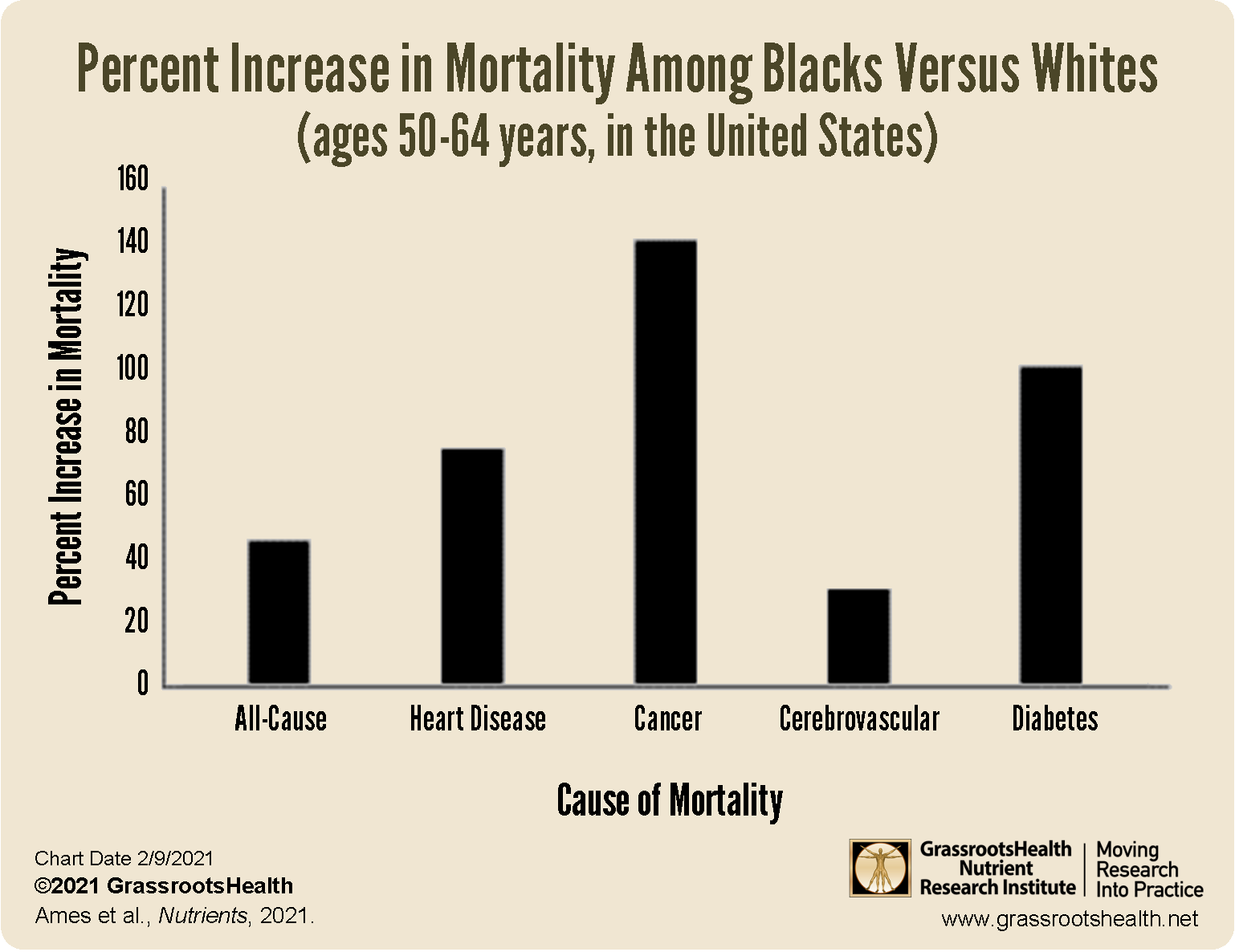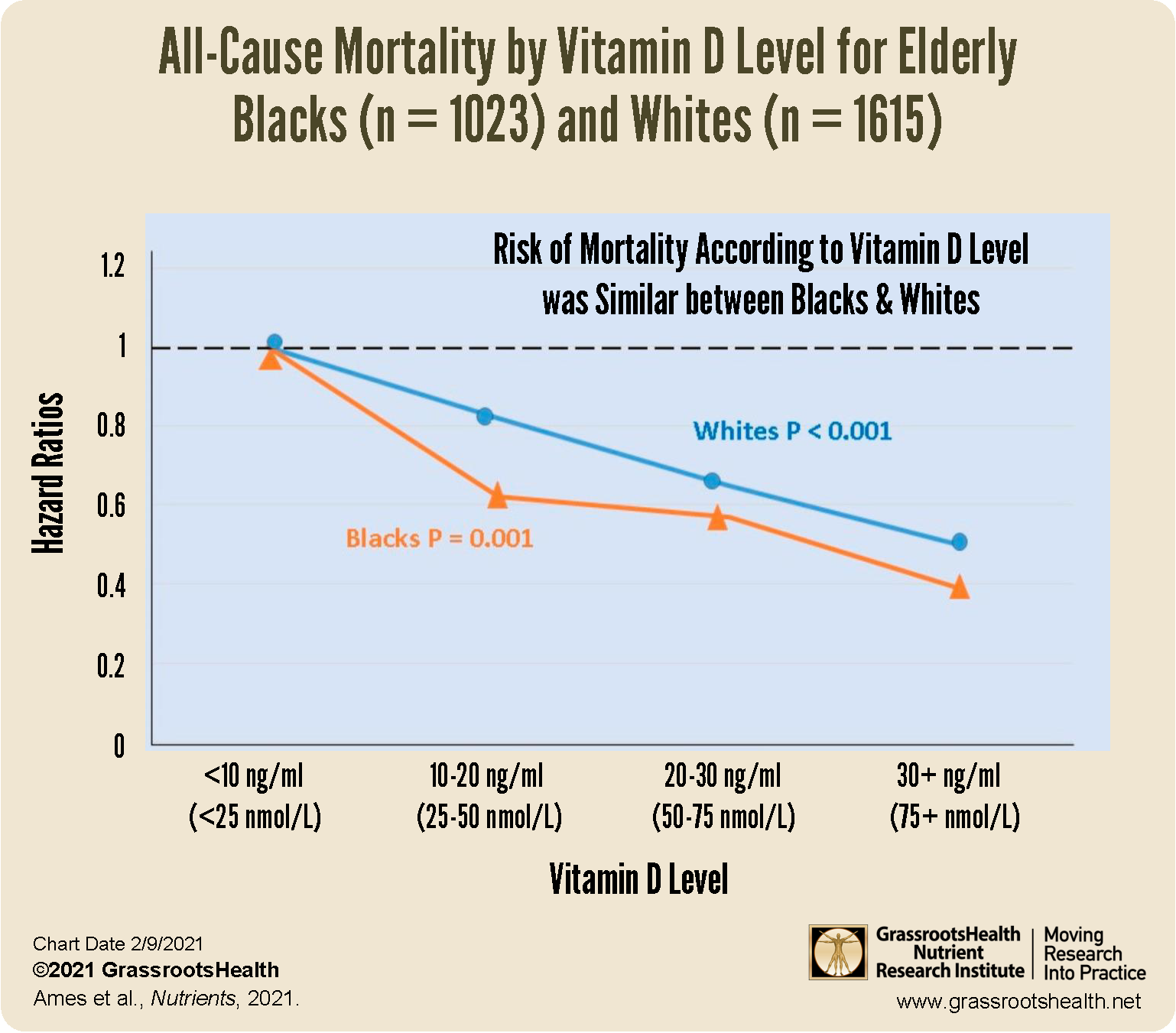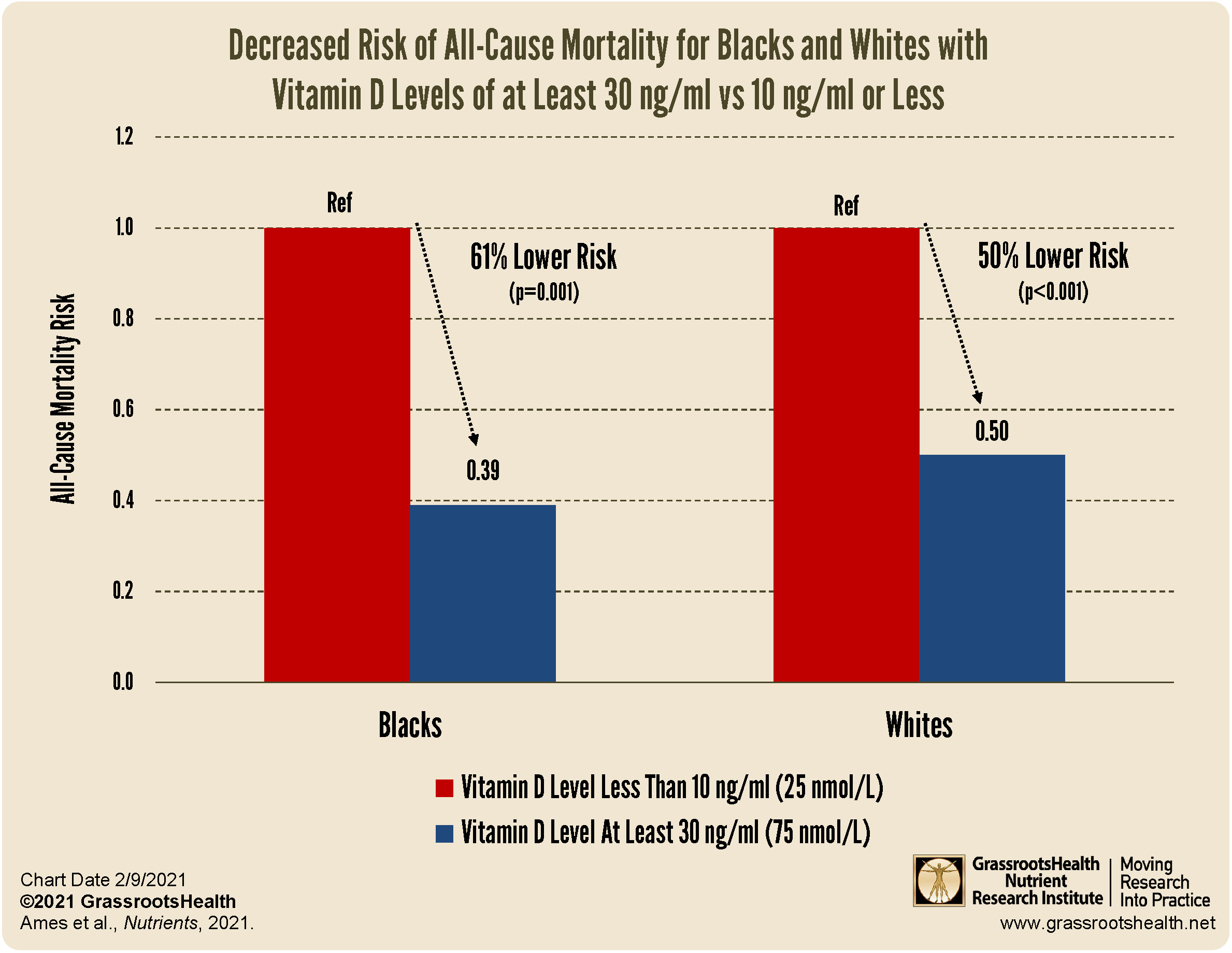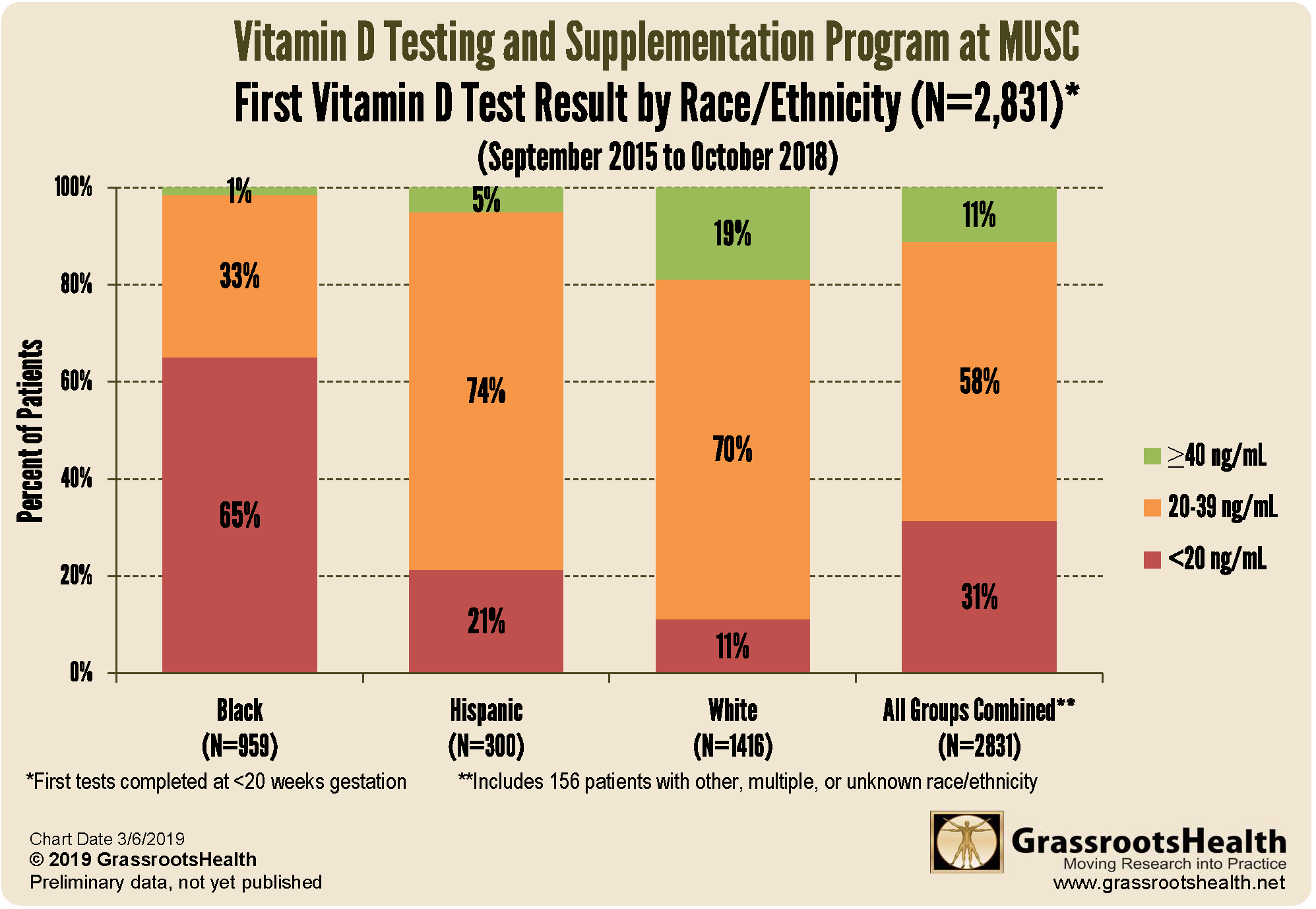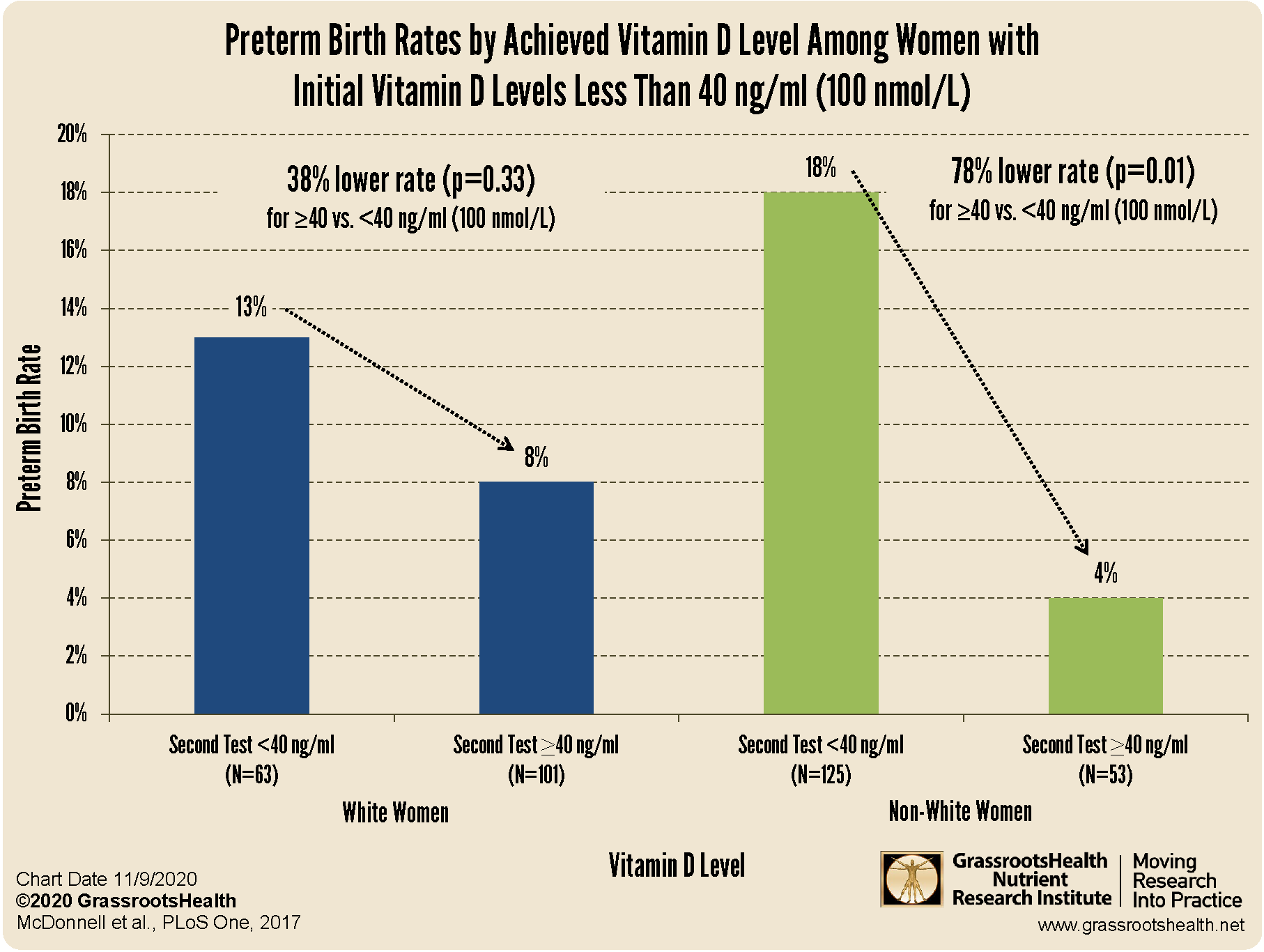Published on February 1, 2023
A summary of research and charts illustrating the gap in health outcomes and mortality between blacks and whites – a gap that virtually disappears when vitamin D deficiency is corrected
Key Points
- Blacks are the most at risk of vitamin D deficiency of all ethnicities
- There is strong evidence that getting vitamin D levels among blacks up to at least 30-40 ng/ml (75-100 nmol/L) alone may eliminate much of the health disparities seen between blacks and whites; one study found a 61% lower risk of mortality for blacks and a 50% lower risk of mortality for whites when vitamin D levels were increased from less than 10 ng/ml (25 nmol/L) to at 30 ng/ml (75 nmol/L) or above
- A study found that pregnant women with vitamin D levels at or above 40 ng/ml compared to women with levels less than 20 ng/ml had a 65% lower risk of preterm birth among white women (p=0.03) and a 68% lower risk among non-white women (p=0.008)
- There was NO difference in preterm birth rates (what was measured in the study) by ethnicity if vitamin D levels were equal; we can erase disparity in preterm birth caused by vitamin D deficiency, according to this analysis, by bringing everyone’s vitamin D levels to at least 40 ng/ml

Blacks are the most at risk of vitamin D deficiency of all ethnicities, and many diseases associated with vitamin D deficiency are also the same ones seen more prevalently among blacks. Because of their darker skin color, blacks require more sun exposure than people with lighter skin to make the same amount of vitamin D – making them much more prone to deficiency.
Below is a summary of research showing the gap in health outcomes and mortality between blacks and whites – a gap that virtually disappears when vitamin D deficiency is corrected.
80% of Blacks Have Vitamin D Levels below 30 ng/ml (75 nmol/L); 95% are below 40 ng/ml (100 nmol/L)
Data from the National Health and Nutrition Examination Survey (NHANES) clearly illustrates the higher rates of vitamin D deficiency among blacks compared to all other ethnicities. Compared to non-Hispanic whites, the risk of being in the lowest grouping for vitamin D levels is
- 10 times greater for non-Hispanic blacks
- 2.5 times greater for Hispanics
- 3 times greater for other races
Blacks also have much Higher Mortality Rates from Diseases Associated with Vitamin D Deficiency
With more blacks having vitamin D deficiency, deficiency related health conditions such as cancer, diabetes, heart disease, and others – and mortality due to these conditions – are seen in much higher rates among blacks compared to whites. The chart below illustrates the percent INCREASE in mortality rates for blacks compared to whites.
Increasing Vitamin D Levels among Blacks to 30-40 ng/ml Lowers Black Mortality Rates
A review by Ames et al. titled Does the High Prevalence of Vitamin D Deficiency in African Americans Contribute to Health Disparities? showed strong evidence that getting vitamin D levels among blacks up to at least 30-40 ng/ml (75-100 nmol/L) may eliminate much of the health disparities seen between blacks and whites. In order to see what effect vitamin D levels had on the mortality rates of blacks compared to whites, the authors created the chart below.
When breaking the mortality risk down by vitamin D level, you can see that the risk of mortality for blacks is similar to the risk of mortality for whites for each category of vitamin D serum level! This indicates that correcting vitamin D deficiency and insufficiency among blacks could close the gap in mortality rates between blacks and whites.
Regardless of Skin Color, Correcting Vitamin D Deficiency Decreases Mortality Risk
Based on the above, the risk of mortality is similar between blacks and whites when mortality is grouped by vitamin D level. Even though more blacks may be in the lower vitamin D categories, with more experiencing higher rates of all-cause mortality, their risk of mortality decreases in the same manner as whites when vitamin D levels increase. As you can see in the chart below, there is a 61% lower risk of mortality for blacks and a 50% lower risk of mortality for whites when vitamin D levels were increased from less than 10 ng/ml (25 nmol/L) to at 30 ng/ml (75 nmol/L) or above.
Preterm Birth Risk in the United States Demonstrates “persistent racial disparities across maternal and infant health measures”
The 2022 report card on the state of maternal and infant health in the United States, presented by the March of Dimes, shows a worsening health crisis for pregnant women and their babies with preterm birth rates reaching a 15 year high. Approximately 15 million babies world-wide will be born prematurely each year, and 1 million will die.
“…the U.S. preterm birth rate increased to 10.5% in 2021 – a significant 4% increase in just one year and the highest recorded rate since 2007… The data also shows persistent racial disparities across maternal and infant health measures that were compounded by the COVID-19 pandemic, making the U.S. among the most dangerous developed nations for childbirth.”
Note that preterm birth (before 37 weeks gestation) and low birth weight (under 5.5 lbs) are associated with increased risk of health problems for the baby, including respiratory problems, feeding difficulties, jaundice, delayed brain development, increase of cerebral palsy, risk of ADHD and autism, as well as an increased risk of infant death.
68% Black Women Have Vitamin D Levels Below 20 ng/ml!
Black women have a 15-20 fold higher prevalence of severe vitamin D deficiency, putting them at much higher risk for preterm birth. According to NHANES data, approximately 68% of Black women have vitamin D levels below 20 ng/ml (50 nmol/L) and at these levels, would be expected to have a 20% preterm birth rate; this is a problem that must be addressed for mothers within these groups of darker skin!
Below, we share our own research showing the gap in preterm birth outcomes between white and black mothers – a gap that virtually disappears when vitamin D deficiency is corrected.
First Trimester Vitamin D Levels
Among pregnant women receiving routine prenatal vitamin D testing, a vast majority (89%) had vitamin D levels less than 40 ng/ml on their first vitamin D test and almost one-third (31%) had vitamin D levels less than 20 ng/ml. Black women had particularly low vitamin D levels; almost all (99%) were less than 40 ng/ml and approximately two-thirds (65%) were less than 20 ng/ml. These vitamin D levels are representative of prenatal vitamin D levels across the United States.
How do race and vitamin D levels affect the risk of having a preterm baby?
We have previously summarized the main results from a published GrassrootsHealth study showing a 62% lower risk of preterm birth for women with vitamin D levels at or above 40 ng/ml (100 nmol/L) compared to women with levels less than 20 ng/ml. Below, we look at another analysis from that paper which assessed the association between vitamin D and preterm birth risk for white and non-white women. This was important to look at due to the racial and ethnic differences in preterm birth rates, with Black women having higher rates compared to other groups.
Among the women in the study (N=1,064), 10% of white women and 15% of non-white women had a preterm birth. Black women accounted for a majority (69%) of the non-white births and had a 19% preterm birth rate. For those with vitamin D levels at or above 40 ng/ml compared to women with levels less than 20 ng/ml, there was a 65% lower risk of preterm birth among white women (p=0.03) and a 68% lower risk among non-white women (p=0.008). The similar decreased risk suggests that improvements in vitamin D status may decrease the disparity in preterm birth rates between racial/ethnic groups.
As illustrated in the chart above, among women whose initial vitamin D level was less than 40 ng/ml, the preterm birth rate was 38% lower among white women (p=0.33) and 78% lower among non-white women (p=0.01) for those who raised their level to at least 40 ng/ml prior to giving birth vs. those who did not.
This indicates that improving the vitamin D status of non-white women, who are more likely to have low vitamin D levels, could dramatically decrease racial disparities in preterm birth rates.
Getting Technical: Vitamin D Level Alone Made a Difference
The most telling part of this analysis comes toward the end of the results section of the paper:
Differences by race/ethnicity were not statistically significant when 25(OH)D concentration was included as a covariate in multivariable regression analysis.
To a statistician this statement means…
there was NO difference in preterm birth rates (what was measured in the study) by ethnicity if vitamin D levels were equal.
This statement is the key to disparity and the plausible conclusion that getting vitamin D levels into recommended ranges (40-60 ng/ml) alone could even out health and mortality risks among these ethnicities.
One Simple Change Makes a BIG Difference
It should now be clear that vitamin D alone has the potential to make a big difference in health outcomes, especially for black individuals. Learn why are blacks more deficient in vitamin D and what can be done to address this issue for all!
How Much Vitamin D Do You Need? Find Out with Your Home Test!
 Having and maintaining healthy vitamin D levels and other nutrient levels can help improve your health now and for your future. Choose which additional nutrients to measure, such as your omega-3s and essential minerals including magnesium and zinc, by creating your custom home test kit today. Take steps to improve the status of each of these measurements to benefit your overall health. With measurement you can then determine how much is needed and steps to achieve your goals. You can also track your own intakes, symptoms and results to see what works best for YOU.
Having and maintaining healthy vitamin D levels and other nutrient levels can help improve your health now and for your future. Choose which additional nutrients to measure, such as your omega-3s and essential minerals including magnesium and zinc, by creating your custom home test kit today. Take steps to improve the status of each of these measurements to benefit your overall health. With measurement you can then determine how much is needed and steps to achieve your goals. You can also track your own intakes, symptoms and results to see what works best for YOU.
Enroll in D*action and Test Your Levels Today!


